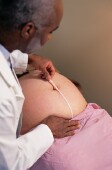 |
 |
 |

Rate of Unnecessary C-Sections Far Lower Than Thought
Estimates put figure at nearly 60 percent; real number may be as low as 4 percent, study finds|
|
HealthDay
Wednesday, December 24, 2008
 WEDNESDAY, Dec. 24 (HealthDay News) -- A new, closer look at data on Caesarean section births in the United States suggests that the actual number of unnecessary surgical deliveries is far lower than previously thought.
WEDNESDAY, Dec. 24 (HealthDay News) -- A new, closer look at data on Caesarean section births in the United States suggests that the actual number of unnecessary surgical deliveries is far lower than previously thought.
When looking at birth certificates alone, it appears the number of C-sections being performed in the United States on women who have no risk factors is almost 60 percent. But government experts who analyzed birth certificates and hospital discharge data found the actual number of such deliveries was closer to 4 percent.
"You can't use the birth certificate alone to determine whether or not a woman is at risk for primary Caesarean delivery," said study author Emily Kahn, an epidemiologist with the U.S. Centers for Disease Control and Prevention's division of reproductive health.
The finding are published in the January issue of the journal Obstetrics and Gynecology.
Nearly one in three babies in the United States was delivered by C-section in 2005, according to the National Center for Health Statistics. That rate is the highest ever, according to background information in the study. The rate of primary Caesareans has increased sharply, while the rate of vaginal delivery after a primary C-section has dropped dramatically.
Trying to assess why the rate has increased, some researchers have turned to birth certificate data to get a population-based estimate of the number of unnecessary C-sections. If the birth certificate says there was "no indicated risk," it appears that those women had Caesareans for no discernable reasons.
Kahn said she and her colleagues were concerned that measuring unnecessary C-sections this way might lead to a large number of these surgeries being classified as unnecessary when, in fact, there were risk factors present to either the mother or baby that necessitated a C-section.
The CDC researchers sifted through data on 565,767 births from women who were considered at low risk for needing a C-section. The women were all 37 weeks' to 41 weeks' pregnant when they went into labor and had singleton pregnancies. All of the women delivered in Georgia hospitals between 1999 and 2004.
More than 70,000 of these women ended up having a Caesarean delivery, and almost 41,000 were listed on the birth certificate as having no risk factors. Yet, in the hospital discharge data, nearly 90 percent of these women had a risk factor listed.
Overall, 58.3 percent of birth certificates suggested no risk factors. But when the researchers pooled the data and combined both birth certificate data and hospital discharge data, they found the rate of Caesareans with no reported risk factors at just 3.9 percent.
Kahn said there are several possible reasons for this discrepancy. One is that the main purpose of a birth certificate is simply to record the birth. Birth certificates aren't completed by physicians, but instead rely on worksheets filled out by the mother. And, she said, hospital discharge data is used to bill the insurance companies and doctors must be very detailed on these reports to get paid, which might make them more accurate.
"Doctors don't touch birth certificates," said Dr. Miriam Greene, an obstetrician at New York University Langone Medical Center and author of the book Frankly Pregnant. "The person who writes up the birth certificate might not be knowledgeable about all the risk factors for C-section, and they see the baby is fine and may think there was no issue."
Kahn said the data from this study suggest that "women who are having primary Caesareans, by and large, do have some sort of risk factor or medical condition that could lead to a Caesarean, though we can't tell on an individual basis."
A lot of the reasons Caesareans are performed are out of a woman's control, but Greene said you can likely reduce your risk by making sure you're well-nourished without gaining too much weight during pregnancy, going to all of your prenatal visits, taking prenatal vitamins and participating in regular exercise.
HealthDay
Copyright (c) 2008 ScoutNews, LLC. All rights reserved.
Related News:
More News on this Date
Related MedlinePlus Pages:
| Home | Health Topics | Drugs & Supplements | Encyclopedia | Dictionary | News | Directories | Other Resources | |
| Disclaimers | Copyright | Privacy | Accessibility | Quality Guidelines U.S. National Library of Medicine, 8600 Rockville Pike, Bethesda, MD 20894 National Institutes of Health | Department of Health & Human Services |
Date last updated: 25 December 2008 |




